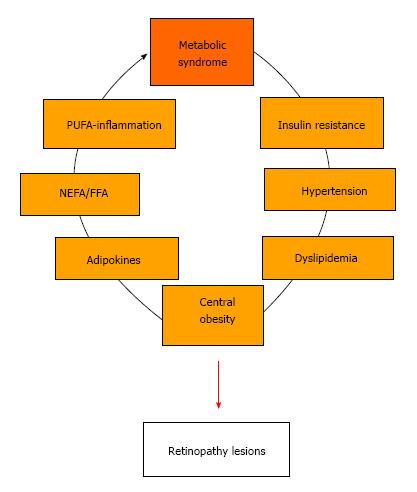Copyright
©The Author(s) 2017.
World J Diabetes. Jul 15, 2017; 8(7): 317-329
Published online Jul 15, 2017. doi: 10.4239/wjd.v8.i7.317
Published online Jul 15, 2017. doi: 10.4239/wjd.v8.i7.317
Figure 1 Schematic presentation of the postulated primary role of hyperglycemia and insulin deficiency in driving diabetic microvascular complications in type-1 diabetes.
Secondary mediators of retinal vascular damage include oxidative stress, inflammation and leukostasis.
Figure 2 Schematic presentation of the multiple pathways involved in metabolic syndrome including hypertension, central obesity, dyslipidemia, adipose tissue and adipokine’s dysfunction, altered free fatty acids levels and polyunsaturated fatty acid metabolism leading to local and systemic inflammation.
FFA: Free fatty acids; PUFA: Polyunsaturated fatty acid.
Figure 3 Schematic presentation of the postulated multifactorial and interrelated pathways of insulin resistance, inflammation, dyslipidemia and hyperglycemia that collectively drive microvascular complications in patients with metabolic syndrome with and without established history of diabetes.
- Citation: Mbata O, Abo El-Magd NF, El-Remessy AB. Obesity, metabolic syndrome and diabetic retinopathy: Beyond hyperglycemia. World J Diabetes 2017; 8(7): 317-329
- URL: https://www.wjgnet.com/1948-9358/full/v8/i7/317.htm
- DOI: https://dx.doi.org/10.4239/wjd.v8.i7.317











